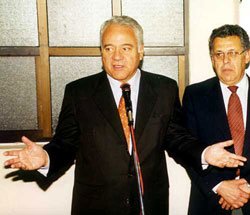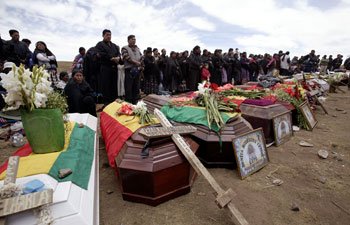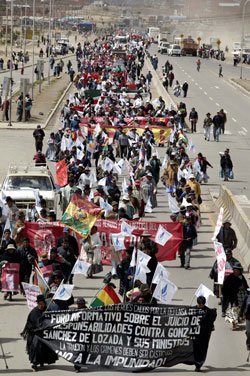


The Long Road to Making “Goni” Pay For His Crimes
His Victims Face Obstacles in their Struggle But Keep Fighting for Justice
By Luis A. Gómez
Part Two of a Special Series for The Narco News Bulletin
December 27, 2004
Luis Castaño is 25 years old, a tall and sturdy construction worker, and a resident of the Villa Ingenio neighborhood. On Sunday, October 12, 2003, he was in the southern part of the city of El Alto visiting his father. During a previous investigation, he told this newspaper how he went out to look for his father and ended up joining the blockades in the Senkata area where people were fighting with the soldiers, trying to stop tanker trucks from leaving a gasoline plant. Castaño took a bullet in the right leg and was taken to the General Hospital after losing a lot of blood.
 Former president Gonzalo Sánchez de Lozada with former minister Javier Torrez Goitia, another one of the accused. Photo: Bolipress.com |
A little more than a year has passed, and after nearly a dozen unsuccessful operations Luis Castaño has lost his entire right leg. Of course, he can no longer work. In his testimony recorded by Verónica Auza and Claudia Espinoza in their book Memorial Testimony of the “Gas War,” the young worker says: “Now I ask for justice, disability compensation, housing, health insurance, and work.” The doctors operated on Castaño for months, and each time he lost a few more inches from his body. The administration of President Carlos Mesa had declared that the relatives of those who died in the insurrection, and all the surviving victims would be “compensated” with money and free medical attention. However, in order to determine the amount of money one would be receive (and the necessary medical coverage) every one of these people had to wait for weeks to receive an official medical evaluation.
Put under the responsibility of the Government Minister’s legal advisor – a shadowy figured who has held the post since the Sánchez de Lozada administration – the wounded, the disfigured, and the relatives of the dead were mistreated, ignored, and faced discrimination. Finally they decided, supported by the Committee for a Trial of Responsibilities, to gather every Thursday at noon in the atrium of the La Paz Cathedral, right next door to the Governmental Palace. There, carrying banners and photos of their relatives, they launched a signature-gathering campaign to ask the National Congress to authorize a trial. Every week, for months, one could come and meet the widows and those who, like Luis Castaño, were wounded or lost parts of their bodies defending Bolivia’s gas and hydrocarbons.
All over the country people began to collect the signatures of Bolivians who were in solidarity with the effort. In some parts of La Paz, screenings were held with videos of the insurrection, to support a campaign that involves organizations like the Coordinating Committee for the Defense of Gas in Cochabamba, several labor unions, and volunteers from all over. But it was not enough; the authorities did little to help them, the judicial bureaucrats went ahead with the process in the wrong way, and the political parties in Congress, without exception, worked very slowly to approve the process.
Victims Don’t Rest
Néstor Salinas, 33, leads the Association of Relatives of the Heroes Fallen in Defense of the Gas, which unites more than fifty grieving families. With his slow, smooth speaking style, Salinas has become a pillar of the movement for justice. In any place that people will listen to him, he has told of his struggle and of his suffering, as he did at the Americas Social Forum last June in Quito, Ecuador. Salinas lost his younger brother David on Saturday, October 11, in El Alto.
 One of the vigils held in El Alto on October 8. Photo: Noah Friedsky |
When Néstor Salinas speaks about his mission to get a trial for Sánchez de Lozada, he always speaks about the strength that the victims must demonstrate. “So much suffering,” he told me one afternoon a few months ago, “must not be in vain.” In late September, tired of waiting for someone to do something for them, the relatives of the fallen organized a series of events from October 8 to 15, during the commemorations for the first anniversary of the insurrection and the massacres. Together with El Alto social organizations, the injured, some sectors of the Catholic Church, and others, the people of many El Alto neighborhoods performed night vigils across the city on Friday, October 8. In plazas and churches, they screened the video Aunque se caiga el cielo (“Even if the Sky Falls”), produced by the Indymedia Bolivia collective to document that October of pain and victory. And in Villa Ingenio, where twenty-six people were killed during the military assault on the neighborhood on October 12, 2003, they made a procession to mark the stations of their grief – on every spot, every corner and every street where someone fell, the neighbors stopped to remember those days of fear and resistance.
 Coffins of the fallen in Villa Ingenio on the morning of October 12, 2004. Photo: Noah Friedsky |
But the judicial bureaucrats in charge of the autopsies played a dirty game with the victims. On October 11, among the bodies taken from their resting places was that of David Salinas, who they went to examine for the third time. With the “coincidental” fact that he was the brother of the main leader of the victims’ relatives on their minds, La Paz District Attorney Audalia Zurita and the doctors and lawyers under her command worked with complete negligence. Néstor Salinas and his people waited an entire day for them and they never showed up. Finally, they arrived that evening at the Tarapacá Cemetery, and said that their work was impossible in the darkness. Fortunately, Dr. Rogelio Mayta and Sacha Llorenti, president of the Permanent Human Rights Assembly, forced them to do a nocturnal autopsy – both activists came to the cemetery with spotlights connected to an automobile to illuminate David Salinas’s tomb while it was examined.…
“For Violations of Individual Rights”
These were the conditions under which the National Congress held its historic October 13 session, in which the trial of “Goni” Sánchez de Lozada was authorized. In his vibrant account of the events, Gissel González, member of the the Coordinating Committee for the Defense of Gas in Cochabamba and graduate of the second session of the Narco News School of Authentic Journalism, recorded the vote count: of those present, 126 voted in favor of the trial, thirteen against, and one vote was submitted blank. It was a session that lasted more than sixteen hours, and that finally culminated the morning of Thursday, October 14. For “security,” all the streets near the Congress building were closed, but that did not stop the relatives of the dead, the injured, and a few others from waiting in suspense in front of the building until the results were known.
Inside, in the Chamber of Deputies (Bolivia’s lower house of Congress), where the so-called “representatives of the people” sat in session, this journalist witnessed the brutish behavior of several congressmen, and the atmosphere of tension these legislative authorities had created. There were around fifty people in the visitor’s gallery: Néstor Salinas, one of the leaders of the wounded, Rogelio Mayta, Sacha Llorenti, three lawyers from Mayta’s team, Claudia Espinoza, Gissel, and the author of this series spent a good part of the session surrounded by more than thirty security agents in civilian cloths, who would occasionally harass the group. Below us, more than one congressman from the Nationalist Revolutionary Movement (MNR in its Spanish initials, the party of Sánchez de Lozada) had the cynicism to defend the ex-president and his actions. Especially notable was Deputy Luis Eduardo Siles, who did not hesitate to announce that he would always defend “Goni” against any attack.
But the move for a trial did pass, and despite the bitter Andean cold that night, the people celebrated in the streets. Before leaving the Congress building to join his comrades, Néstor Salinas said to me, his face pale, that his heart could finally rest a bit. After days of exhaustion, of seeing the body of what had been his beloved brother, of carrying coffins, of fighting for justice, it seemed that bitter struggle had finally begun to bear fruit. Gissel González recorded part of his speech in the streets: “Now comes the hardest and most difficult part… getting justice.”
“For the Poor, Justice Is Not Blind, It’s Deaf”
On their way to bringing “Goni” Sánchez de Lozada to Chonchocoro – Bolivia’s maximum-security prison – the wounded and the relatives of the fallen have had to travel great distances and go from one corrupt bureaucrat to the next. On October 15, with the trial now authorized by the legislature, several marches were held to put pressure on the state authorities. Reliving the days of insurrection a year earlier, the masses marched on crutches, the widows wore their black mourning clothes, the unions chanted the names of the heroes in the streets of El Alto, in the streets of La Paz.…
 A march on October 15 commemorates the days of struggle last year and demands justice. Photo: Noah Friedsky |
While Sánchez de Lozada’s lawyers and several of his former ministers took it upon themselves to question every step of the process that led to the trial’s authorization, on July 30 the Mesa administration made several judicial appointments. Such appointments usually fall under the Congress’s jurisdiction, but faced with congressional inefficiency, Mesa went ahead and named an interim attorney general and several district attorneys, among other posts. To make things even more complicated, a congressman from the Movement of the Revolutionary Left, Renán Paco Granier, sent a request to the Bolivian Constitutional Tribunal to nullify these appointments.
“We know that one week before the tribunal gave its ruling, one of the tribunal’s ministers was in Miami [probably meeting with Sánchez de Lozada and his people]. Another minister on that tribunal was Martha Rojas, the infamous former antinarcotics prosecutor who worked for Sánchez Berzaín,” says Mayta. “This put everything the interim authorities did into question, such as the court investigations carried out by ex-Attorney General César Suárez and La Paz District Attorney Audalia Zurita.”
The court’s ruling, published November 10, ordered President Carlos Mesa and Congress to take emergency actions to make new judicial appointments. This led to a series of extra-ordinary sessions of Congress last week. After intense negotiations, in which the traditional political parties tried to hand out positions as if they were spoils of war to be divided up, new dangers for the trial appeared on the horizon. One of the candidates for attorney general – the top law-enforcer who would be participating in the trial – was Eduardo Sfeir, an old collaborator of Sánchez de Lozada’s, former consultant for the United States embassy, and known activist for Sánchez de Lozada’s MNR party.
Threats and Bribes
“Last Monday [December 13] we went with the associations of the wounded and the relatives of the fallen to put pressure on the Congress. However, the new leader of the wounded, Daniel Sánchez, appeared on television that day saying his organization supported Eduardo Sfeir,” says Rogelio Mayta. Something was very wrong, and Mayta decided to confront Sánchez directly and ask him how much they had given him to support Sfeir. Putting together the facts, Mayta discovered a plot that had been in motion since August, in which Sfeir, in return for the support of the leadership of the injured, offered to give the association 200 parcels of land in El Alto. “We know that it was a non-governmental organization that offered them the land,” says Mayta, “but we also suspect that Sánchez and the other leaders had already received a lot of money… there is no way they did this on their own.”
On the afternoon of Tuesday the 14th, coca growers’ leader and congressman Evo Morales claimed, in Congress, that congressmen were receiving $2,000 to vote for Sfeir. In the negotiations between the political parties many names were tossed about, but none of them was Eduardo Sfeir. “Surprisingly,” remembers Maytak, “in that night’s vote, Sfeir came in second, appearing once again on the scene.”
Fortunately, thanks to one of the few brilliant moves in Congress by Evo Morales’s Movement Towards Socialism party, a new attorney general was finally chosen that Wednesday. It was Pedro Gareca, who served once before as interim attorney general just in time to oversee the last trial of responsibilities in this country, against ex-dictator Luis García Meza in the 1980’s. In one of his first announcements from his new post, Gareca said that he could ask for Sánchez de Lozada’s extradition from the United States if the former president does not appear for the trial. This has moved Sánchez de Lozada to consider applying for political asylum in the U.S., despite the fact that he already has residency there.
“He is a man who keeps a low profile,” says Mayta of the new top legal authority, “but we expect a lot from him.”
Meanwhile, a lawyer named Gisely Cerval has requested that the list of those accused of during gas war be widened to include Bolivian social leaders. Working with unusual speed, the prosecutors assigned to the case have already called nearly everyone to testify: Evo Morales, Roberto de la Cruz, Jaime Solares, and Oscar Olivera (though Olivera’s testimony was never recorded, due to “lack of resources” to send prosecutors six hours south to Cochabamba). “They haven’t called in, for example, a single soldier,” Mayta points out.
Mayta has also received threats. “That Monday, when they were beginning to discuss appointments in Congress, I received a call on my cellphone. They told me, ‘don’t mess with Sfeir,’ and hung up.”
Now, the people involved with this fight are preparing the next steps to move forward. “The situation right now is interesting,” Mayta explains. “Once all the defendants are notified, we have up to three years to put our evidence together. We don’t have a lot of resources for this, but we are trying not to lose this battle.”
Finally, despite all the obstacles, real justice continues on its course. “So much movement, so many traps set for us, have left people uncertain,” confesses Mayta. The fifteen accused still have a lot of loopholes to hide in. One of them is that Law 2445, which regulates the prosecution of state dignitaries, contains no clear legal procedure for the process. “That’s why, so as not to fall off course, we are proposing that Congress pass an interpretive law clearly explains the situation and the correct path to follow.”
And so, as social leader Oscar Olivera said when called to testify on the events of October 2003: “Justice in the case of simple working people is not blind, but deaf… and in the case of people with money, of the powerful, it is simply cowardly.” In any case, those hands and those feet that one year ago removed Sánchez de Lozada from power will be the hands and feet that make sure he and his underlings pay for their crimes. In this war between memory and power, some people are working to guarantee justice.
Lea Ud. el Artículo en Español
- The Fund for Authentic Journalism
For more Narco News, click here.




